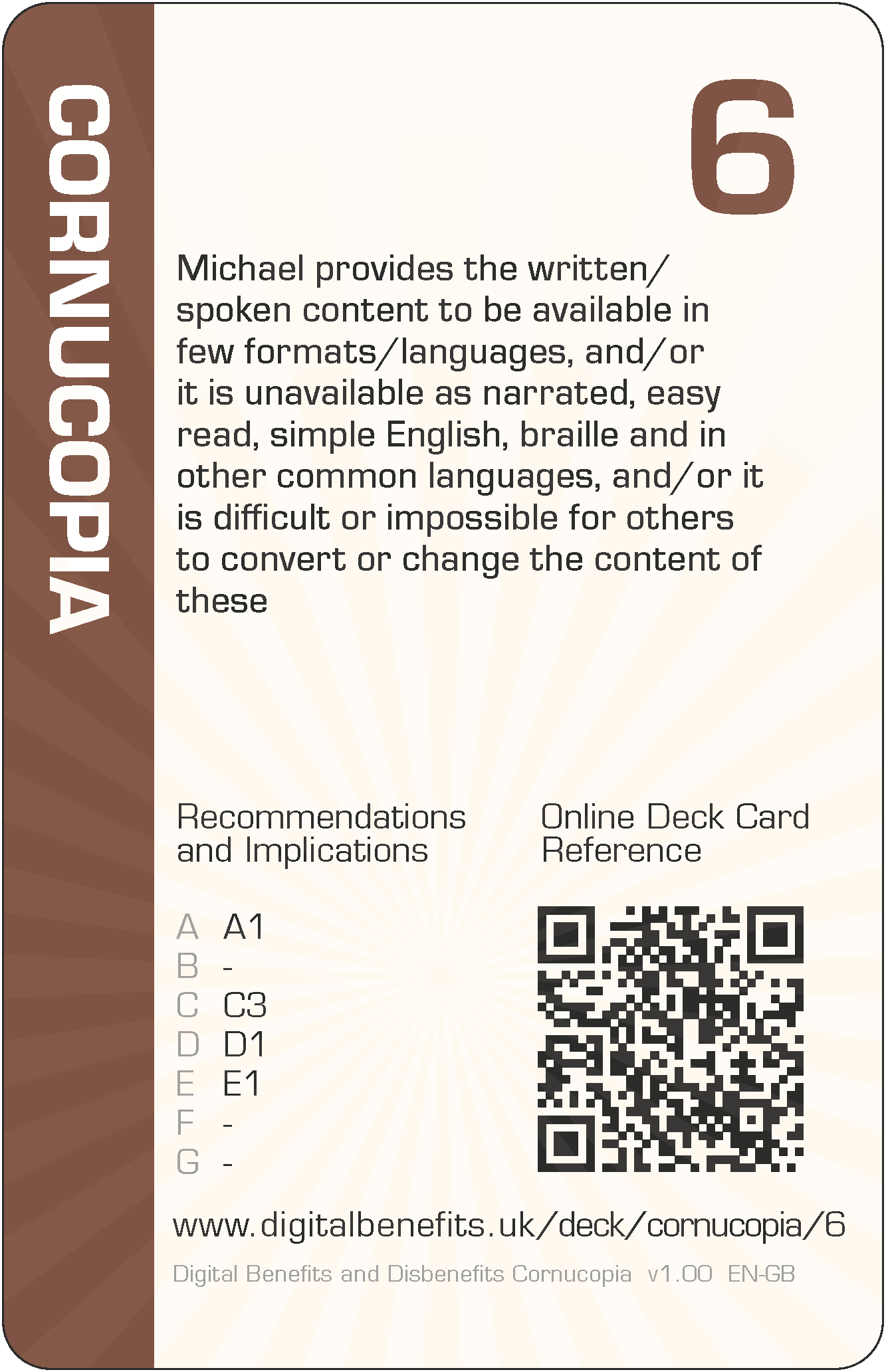Cornucopia 6 (CO-6) Card
DBD Cornucopia > Deck > Cornucopia > 6
Card Details - Six of Cornucopia
Abbreviation
CO-6
Card's focus
The focus of this card is languages
Threat to claimants
Michael provides the written/spoken content to be available in few formats/languages, and/or it is unavailable as narrated, easy read, simple English, braille and in other common languages, and/or it is difficult or impossible for others to convert or change the content of these

Threat to claimants
Michael provides the written/spoken content to be available in few formats/languages, and/or it is unavailable as narrated, easy read, simple English, braille and in other common languages, and/or it is difficult or impossible for others to convert or change the content of these.
Some examples of how this threat could lead to harms (negative effects on claimants)
The design recommendations and implications relevant to the card are listed below in the next section, but even those can be somewhat abstract and difficult to think about during practical day-to-day implementation. Therefore, some example harms are provided to complement the more formal research outputs. These examples are unique per card, and are only published on these web pages (i.e. in no other project outputs).
- Eligible claimants copy instructional phrases from the service into a translation app to read it in their best language, but unfortunately the translation app does not understand much of the contextual meaning or legislative intent, so claimants are left with misunderstandings which limit making successful claims
- The way the system works prevents easily converting text into speech, so claimants cannot always use their preferred method of communication, thus increasing the mental effort required of them
- The application is developed to offer both Welsh and English content, but general support for multi-lingual content is not built in, so other languages used by claimants cannot be easily incorporated later
The examples are to help understand the threat on the card, not to suppress thinking and innovation. Incorporating these examples exactly, or closely matching ones, should be scored down when playing DBD Cornucopia as a game.
Applicable design recommendations and implications
These are reproduced here from Research Briefing N
Support claimants’ own ecosystems
- Recognise how wider ecosystems contribute to social protection service delivery
For these systems, the 'service user' is rarely just one person and there should be provision for other actors in people's wider ecosystems. Facilitate and aid these existing assets by enabling, encouraging and promoting information sharing, additional user roles with different privileges, delegated access, real-time-integrations, and other ways to involve the assistance of others.
Reduce claimants’ interaction burdens with digital welfare
- Provide full social protection services across wider interoperable channels
Ensure all service provision and modes of assistance (e.g., provision of advice, practical support and self-help guidance) are available through multiple interaction channels (e.g., telephone, web, mobile app) which are accessible to varying resources and capabilities (e.g., communication skills, equipment, language, physical and mental abilities). Permit the use and intermixing of channels without restriction. Consider providing on-demand synchronous interactions through digital as well as other channels.
Embrace a wider ecosystem and fuller claimant activity viewpoint for digitised public services
- Legitimise extensibility and customisation of digital infrastructure
Deploy technology in ways that will permit, support and advocate integration with digital welfare by other actors. Provide timely, free and open access to system information, supporting content, and details of upcoming changes and updates to support these efforts.
Design systems which support the division of labour with claimants' ecosystems
- Integrate accurate specific and contextual primary guidance about making claims within systems and promote secondary professional assistance
None
General Notes
Card values (i.e. '6' for this card) are for game play and are not correlated with the severity of harm. This is because threats cannot be ranked directly since they can affect individuals in different ways due to situations and circumstances, or affect fewer or more claimants, or the harms can arise in claimants' support networks and wider society.
The threat description uses a person's name as the "attacker" (i.e. 'Michael' for this card), which can be thought of someone involved with implementation. They could have any role which influence digitisation. So they could be a database administrator, or a copy writer, or a quality assurance specialist, etc, or all of these. Everyone could have some influence on the claimant threat described. The names were randomly selected from those currently most popular as given names for boys and girls (UK Office for National Statistics).
The example harms provided are drawn from the research data (which explored not only parts of existing services but also the effects of possible changes to those), from the author's own knowledge of web application development and testing, the author's own experience of helping citizens to claim Universal Credit (UC) and Personal Independence Payment (PIP), and from suggestions submitted by other people (make a suggestion). The threats and example harms do not necessarily exist in the current UC or PIP deployments or in ecosystems around those services, but they might well do.
All the cards in this Cornucopia suit are: 2 3 4 5 6 7 8 9 10 J Q K A
The other suits in the deck are: Scope, Architecture, Agency, Trust and Porosity (plus Jokers).
